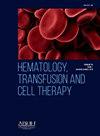SICKLE CELL DISEASE UPDATE: NEW TREATMENTS
IF 1.8
Q3 HEMATOLOGY
引用次数: 0
Abstract
Sickle-cell disease is the most common genetic blood disorder, causing blockage of the circulation and resulting painful vaso-occlusive episodes, acute chest syndrome, stroke, chronic anemia, and multiorgan failure, with increased mortality. Three novel medications have been approved in the past five years: L-glutamine in 2017, and voxelotor and crizanlizumab in 2019. L-glutamine treatment was linked to a reduction in the rate of RBC transfusions as well as a decrease in hospitalizations, pain crises, and the period between the first and second crises. By raising adenosine triphosphate and lowering 2,3-diphosphoglycerate, a glycolytic red blood cell intermediate, mitapivat, an oral pyruvate kinase activator, also has therapeutic potential. Crizanlizumab, a P-selectin inhibitor, reduces the grade of inflammation by lowering the adhesion between the endothelium and leukocytes, sickled red blood cells, platelets, and endothelial cells. Crizanlizumab is associated with a decrease in the requirement for opiate use as well as a decrease in the number of pain crises and the time until the first crisis. Adverse effects include infusion reactions, headache, nausea, and insurance difficulty. Voxelotor increases hemoglobin levels and affinity for oxygen, preventing HbS polymerization, and lowering hemolysis indicators in the process and was associated with lower hemolysis indicators and higher hemoglobin. Insurance denial and adverse effects like headache, rash, and diarrhea were obstacles to using Voxelotor. None of these therapies, however, are curative. There are efficient cell-based treatments including red blood cell exchange, and hematopoietic stem cell transplantation is the only treatment that can cure the disease. Gene editing has shown promise in the treatment of β-thalassemias and sickle cell disease.
求助全文
约1分钟内获得全文
求助全文
来源期刊

Hematology, Transfusion and Cell Therapy
Multiple-
CiteScore
2.40
自引率
4.80%
发文量
1419
审稿时长
30 weeks
 求助内容:
求助内容: 应助结果提醒方式:
应助结果提醒方式:


